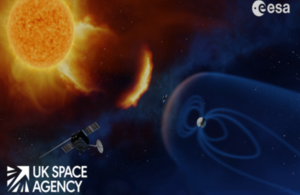
The UK Space Agency will work with the United States in establishing an enhanced space weather forecasting system
The UK will develop a new instrument for use on space weather monitoring spacecraft to observe the solar wind, in order to protect astronauts, satellites and ground infrastructure.
The Sun is always emitting magnetised plasma called the 'solar wind'. While conditions are often benign, strong solar wind can produce disruptive space weather by disturbing the Earth's magnetic field.
More severe space weather can occur when the Sun occasionally discharges large bubbles of magnetised plasma known as coronal mass ejections. Extreme events can be hazardous to astronauts and impact electrical infrastructure, telecommunications systems, aviation and satellite navigation.
Thanks to €8 million (£7million) funding from the UK Space Agency, allocated through the European Space Agency (ESA), scientists at UCL's Mullard Space Science Laboratory (MSSL) will develop a cutting edge 'plasma analyser' which, when placed in deep space, will give early warning of imminent, damaging space weather.
Space weather is a global concern, so the UK Space Agency and ESA will collaborate closely on science, space and ground systems technology with the National Aeronautics and Space Administration (NASA) and National Oceanic and Atmospheric Administration (NOAA) in the United States.
Dr Graham Turnock, CEO UK Space Agency said:
Space weather has the potential to cause severe disruption to critical satellite and ground-based infrastructure, so it's essential that we take steps to mitigate this threat through improving our ability to forecast extreme solar activity.
The space weather mission projects our global influence by partnering with Europe and the USA, driving and protecting future UK knowledge and prosperity, and keeping Britain safe and secure from potential impacts of space weather.
Due to the potential for disruption and impact on industry, space weather appears on the UK National Risk Register.
In the next 5 years NOAA and ESA with support from the UK are planning to launch two complementary solar monitoring satellites. The UK's 'plasma analyser' will fly on ESA's L5 space weather monitoring mission to observe solar wind. The UK Space Agency is working cooperatively with ESA and the United States' NOAA on their complementary L1 space weather monitoring spacecraft. RAL Space in the UK are also working on optical instruments for space weather missions under the current ESA programme.
Director of UCL's Mullard Space Science Laboratory, Professor Andrew Fazakerley, said:
UCL has many years of research experience in the science of space weather and in building instruments with which to study it, most recently through roles in providing both solar and space plasma instruments for ESA's upcoming Solar Orbiter mission.
I am very pleased that UCL will be able to build on that experience to provide a solar wind plasma analyser designed to meet the special requirements of dedicated operational space weather monitoring missions.
The solar wind data generated by this instrument, and others at L1, are vital to enable the Met Office Space Weather Operations Centre (MOSWOC) to issue timely space weather alerts and warnings to assist Critical National Infrastructure operators to effectively mitigate the risk posed by space weather.
Head of Space Weather at the Met Office Mark Gibbs said:
The Met Office Space Weather Operations Centre (MOSWOC) is one of three space weather prediction centres around the globe. It provides vital information to help build the resilience of UK infrastructure and industries to space weather, thereby supporting continued economic growth.
Due to the potential for disruption and impact on industry, space weather appears on the UK National Risk Register. The solar wind data generated by this instrument, and others at L1, are vital to enable MOSWOC to issue timely space weather alerts and warnings. This assists Critical National Infrastructure operators to effectively mitigate the risk posed by space weather.
Understanding our Sun is critical to ensuring space safety. Due to launch in 2020, the UK built ESA Solar Orbiter, which also includes significant cooperation with NASA, will be the first science spacecraft to provide close-up views of the Sun's polar regions, helping us to understand how solar storms develop.
A report by PricewaterhouseCoopers estimates that cost savings for Europe arising from disruption and damage mitigation due to accurate space weather forecasting could be up to €2.6 billion, predicting a return of €6.25 for every Euro of public spending on space weather technology.
The UK Space Agency is driving the growth of the space sector as part of the Government's Industrial Strategy and continues to be a leading member of European Space Agency, which is independent of the EU. The UK is also playing a major role in space exploration and science, with a British built rover going to Mars in 2020.






